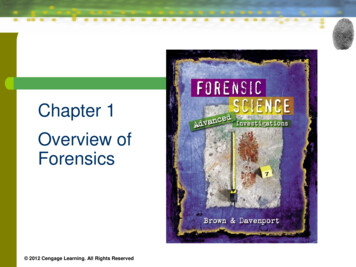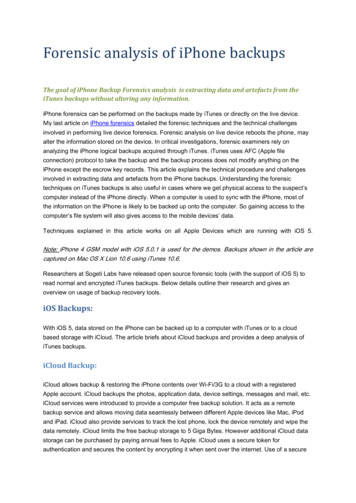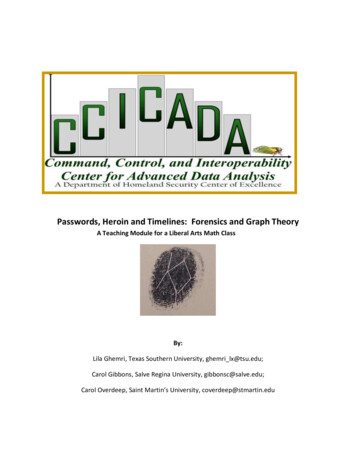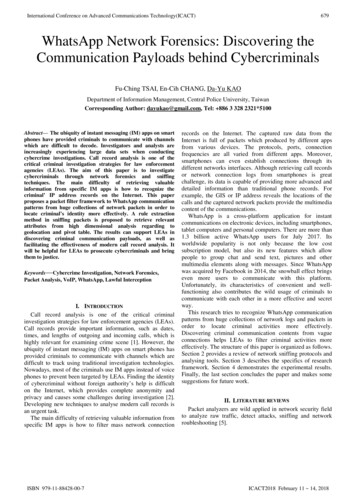
Transcription
Chapter 1Overview ofForensics 2012 Cengage Learning. All Rights Reserved
Introduction—Objectives1. Define forensic science.2. Describe the significance of the keycontributors to the field of forensics.3. Explain how forensic science relies onmultiple disciplines to solve crimes.4. Describe how the scientific method is usedto solve forensic science problems.5. Describe the search methods used tosearch a crime scene.2Forensic Science II: Overview of Forensics, Chapter 1 2012 Cengage Learning. All Rights Reserved
Introduction—Objectives6. Describe proper techniques for collectionand packaging of physical evidence.7. Distinguish between class and individualevidence.8. Discuss the importance of significant casesthat have impacted forensic science.9. Outline the steps of the judicial processfrom identification of a suspect through thetrial.3Forensic Science II: Overview of Forensics, Chapter 1 2012 Cengage Learning. All Rights Reserved
Introduction—Vocabularyoooo4chain of custody - a list of all people who came intocontact with an item of evidenceclass characteristics - properties of evidence thatcan be associated only with a group and never asingle sourceFrye Standard - rule of admissibility of evidence;evidence, procedures, and equipment presented attrial must be generally accepted by the relevantscientific communityindividual characteristics - properties of evidencethat can be attributed to a common source with anextremely high degree of certaintyForensic Science II: Overview of Forensics, Chapter 1 2012 Cengage Learning. All Rights Reserved
Introduction—Vocabularyoooo5Locard’s exchange principle - when two objectscome into contact with one another, a cross-transferof materials occursphysical evidence - any object that can establishthat a crime has been committed or can link asuspect to a victim or crime scenereference sample - a sample from a known sourceused for comparison, also referred to as exemplarscientific method - a series of logical steps toensure careful and systematic collection,identification, organization, and analysis ofinformationForensic Science II: Overview of Forensics, Chapter 1 2012 Cengage Learning. All Rights Reserved
Murders at the Mansionooooooo6The Menendez brothers - Lyle (21) and Erik (18)August 20 1989 — the brothers’ story is that theywent out for the eveningThe brothers call 911 at 11:47 to report the murderof their parentsAfter paying debts, there’s a 2 million estateBy end of year, the brothers spent half of the estateArrested in March 1990; indicted on Dec 8, 1992Defense admits brothers killed their parents, butclaims sexual, physical, and emotional abuseForensic Science II: Overview of Forensics, Chapter 1ForensicScience Learning.II: Title, Chapter# Reserved 2012 CengageAll Rights
Historical Development (Obj 1.2)oooo7Alphonse Bertillon (1853–1914) — developed thefirst method of criminal identificationSir Edward Richard Henry (1850–1931) —developed a fingerprint identification system thatcategorized fingerprints by whorl, loop, or archpatternKarl Landsteiner (1868–1943 — discovered bloodgroupsEdmond Locard (1877–1966) — founder of theInstitute of Criminalistics at the University of Lyon inLyon, FranceForensic Science II: Overview of Forensics, Chapter 1 2012 Cengage Learning. All Rights Reserved
Historical Development (Obj 1.2)oooo8Calvin Goddard (1891–1955) — invented thecomparison microscopeRosalind Franklin (1920–1958) — studied themolecule’s structure using X-ray diffractionphotography of DNAJames Watson (1928– ) and Francis Crick (1916–2004) — using Franklin’s photography, constructeda structural model of DNAAlec Jeffreys (1950– ) — invented DNAfingerprintingForensic Science II: Overview of Forensics, Chapter 1 2012 Cengage Learning. All Rights Reserved
A Multidisciplinary Approach (Obj 1.3)Examples:Forensic nurseForensic chemistForensic toxicologistForensic meteorologistForensic accountant9Forensic Science II: Overview of Forensics, Chapter 1 2012 Cengage Learning. All Rights Reserved
The Scientific Method (Obj 1.4)10Forensic Science II: Overview of Forensics, Chapter 1 2012 Cengage Learning. All Rights Reserved
The CSI Team and Crime Labs(Obj 1.5, 1.6, 1.7)The crime-scene investigation team is a teamof legal and scientific experts who worktogether to process a crime scene andevaluate the evidence11Forensic Science II: Overview of Forensics, Chapter 1 2012 Cengage Learning. All Rights Reserved
The CSI Team and Crime Labs(Obj 1.5, 1.6, 1.7)12Forensic Science II: Overview of Forensics, Chapter 1 2012 Cengage Learning. All Rights Reserved
The CSI Team and Crime Labs(Obj 1.5, 1.6, 1.7)Processing a Crime SceneInvestigators choose the search method based on the size andlocation of the crime sceneZone: building or other structure—homicide, homeinvasion, robbery, sexual assault, etc.Spiral: large area, no barriers—open field—kidnapping, homicideLine search: large area looking for a large object ina single direction—site of a plane crashGrid: large area looking for a large object in twodirections—arson investigation13Forensic Science II: Overview of Forensics, Chapter 1 2012 Cengage Learning. All Rights Reserved
The CSI Team and Crime Labs(Obj 1.5, 1.6, 1.7)ooo14Testimonial evidence — the witnesstestimony used to build a timeline of eventsPhysical evidence —any material collectedor observed at a crime scene that could linkpotential suspects to a crimeWhat is Chain of Custody?Forensic Science II: Overview of Forensics, Chapter 1 2012 Cengage Learning. All Rights Reserved
EvidenceoChain of Custody 15Provides documentation of every person who hascome into contact with the evidenceA paper trailDemonstrates to the courts that the evidence thatis being presented at trial is free of contamination,alteration, or substitutionForensic Science II: Overview of Forensics, Chapter 1 2012 Cengage Learning. All Rights Reserved
Evidenceoooo16Trace EvidenceReference samplesClass characteristicsIndividual characteristicsForensic Science II: Overview of Forensics, Chapter 1 2012 Cengage Learning. All Rights Reserved
Evidence17Forensic Science II: Overview of Forensics, Chapter 1 2012 Cengage Learning. All Rights Reserved
Landmark Cases (Obj 1.8)Frye v. United States (1923)The Frye Standard — evidence, procedures,and equipment presented at trial must begenerally accepted by the scientificcommunity18Forensic Science II: Overview of Forensics, Chapter 1 2012 Cengage Learning. All Rights Reserved
Landmark Cases (Obj 1.8)Daubert v Merrell Dow Pharmaceuticals (1993)U.S. Supreme Court ruled that the trial judgehad ultimate decision-making powerregarding expert testimony at trial1. Has it been tested?2. Has it been peer reviewed?3. What is the rate of error?4. Is it generally accepted?19Forensic Science II: Overview of Forensics, Chapter 1 2012 Cengage Learning. All Rights Reserved
Landmark Cases (Obj 1.8)20Forensic Science II: Overview of Forensics, Chapter 1 2012 Cengage Learning. All Rights Reserved
Landmark Cases (Obj 1.8)Dr. Carl Coppolino (1963)o The court ruled 21The fact that a technique, test, or procedure isnew does not necessarily mean its findings areinadmissible in courtThe expert witness is responsible for providingscientifically valid testimony to support thefindingsForensic Science II: Overview of Forensics, Chapter 1 2012 Cengage Learning. All Rights Reserved
The Judicial Process (Obj 1.9)ooThe U.S. Constitution (1787)The Bill of Rights (1789) 22The first ten amendments to the constitutionSixth amendment ensures that a person will betried by an impartial jury of his or her peersForensic Science II: Overview of Forensics, Chapter 1 2012 Cengage Learning. All Rights Reserved
The Judicial Process (Obj 1.9)oArrest - gathering evidence to show probablecause oo23ObservationExpertiseInformationCircumstantial evidenceBefore the Trial — the discovery phaseAt the Trial — prosecution and defensepresent their casesForensic Science II: Overview of Forensics, Chapter 1 2012 Cengage Learning. All Rights Reserved
24Forensic Science II: Overview of Forensics, Chapter 1 2012 Cengage Learning. All Rights Reserved
Chapter Summaryoooo25Forensic science is the application of science to law.Many disciplines are utilized in forensic science.Processing a crime scene requires a thorough andsystematic approach.Physical evidence is any substance that can link apotential suspect to a victim or crimeForensic Science II: Overview of Forensics, Chapter 1 2012 Cengage Learning. All Rights Reserved
Chapter Summaryooo26When processing evidence, investigators useidentification and comparison tests to attempt tomake connections between victims, suspects, andcrime scenes.Evidence that possesses class characteristics canbe associated with a group rather than with aspecific individual.Evidence that possesses individual characteristicscan be associated with a single person with a highdegree of certainty.Forensic Science II: Overview of Forensics, Chapter 1 2012 Cengage Learning. All Rights Reserved
Chapter Summaryoooo27A chain of custody is necessary to maintain theintegrity of the evidence.The judicial process in the United States is based onthe U.S. Constitution.Law enforcement personnel must prove probablecause before a judge will sign a search or arrestwarrant.In court, a jury of the suspect’s peers hears evidencefrom both sides.Forensic Science II: Overview of Forensics, Chapter 1 2012 Cengage Learning. All Rights Reserved
3 Forensic Science II: Overview of Forensics, Chapter 1 2012 Cengage Learning. All Rights Reserved Intr










